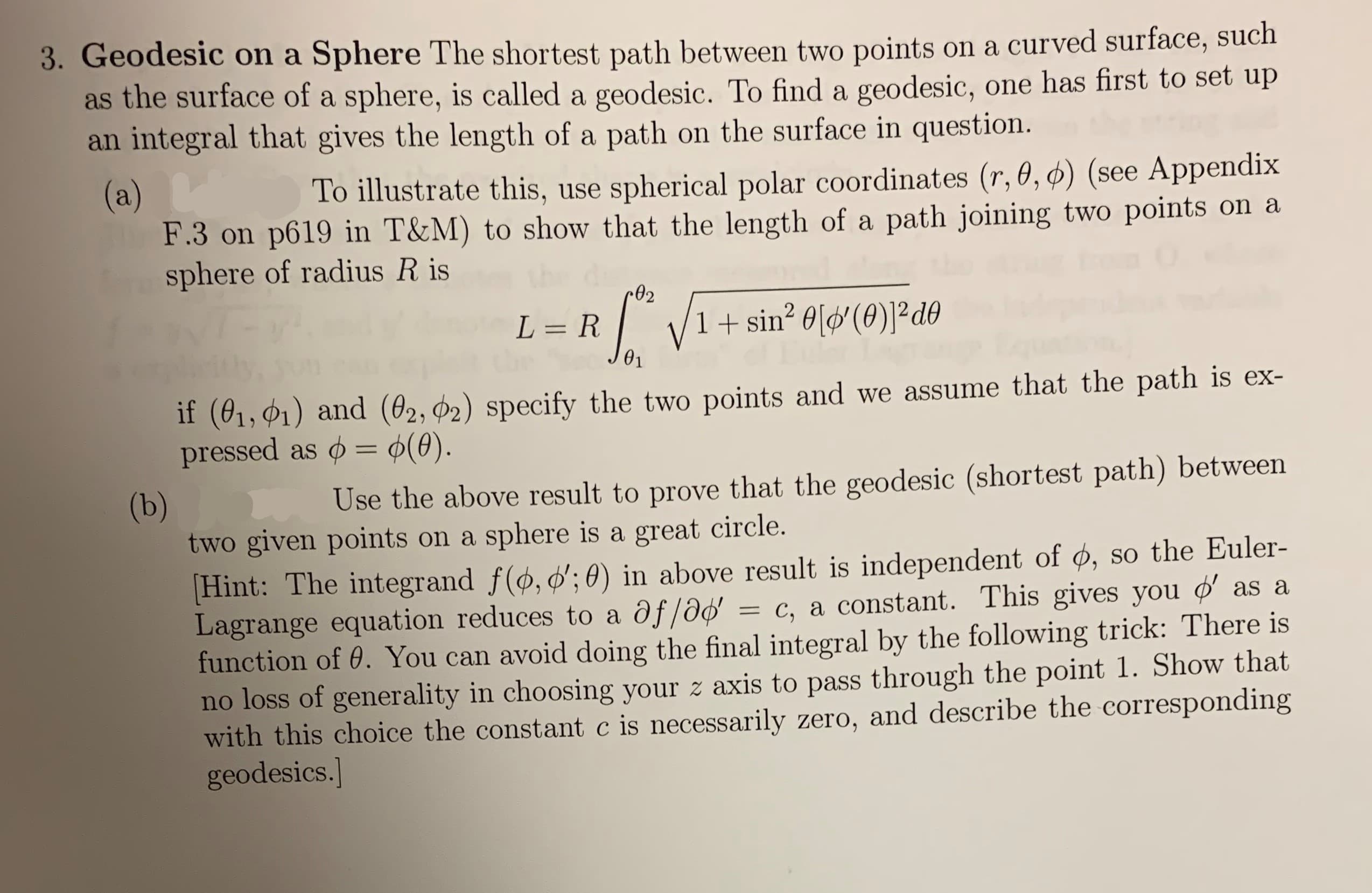3. Geodesic on a Sphere The shortest path between two points on a curved surface, such as the surface of a sphere, is called a geodesic. To find a geodesic, one has first to set up an integral that gives the length of a path on the surface in question. (a) F.3 on p619 in T&M) to show that the length of a path joining two points on a sphere of radius R is To illustrate this, use spherical polar coordinates (r, 0, ø) (see Appendix 1+sin2 0l(0)2 de L=R 01 if (01,1) and (02, P2) specify the two points and we assume that the path is ex- pressed as = (0). (b) two given points on a sphere is a great circle. Use the above result to prove that the geodesic (shortest path) between Hint: The integrand f(o, ;0) in above result is independent of ø, so the Euler- Lagrange equation reduces to a af/od = c, a constant. This gives you as a function of 0. You can avoid doing the final integral by the following trick: There is no loss of generality in choosing your z axis to pass through the point 1. Show that with this choice the constant c is necessarily zero, and describe the corresponding geodesics.
3. Geodesic on a Sphere The shortest path between two points on a curved surface, such as the surface of a sphere, is called a geodesic. To find a geodesic, one has first to set up an integral that gives the length of a path on the surface in question. (a) F.3 on p619 in T&M) to show that the length of a path joining two points on a sphere of radius R is To illustrate this, use spherical polar coordinates (r, 0, ø) (see Appendix 1+sin2 0l(0)2 de L=R 01 if (01,1) and (02, P2) specify the two points and we assume that the path is ex- pressed as = (0). (b) two given points on a sphere is a great circle. Use the above result to prove that the geodesic (shortest path) between Hint: The integrand f(o, ;0) in above result is independent of ø, so the Euler- Lagrange equation reduces to a af/od = c, a constant. This gives you as a function of 0. You can avoid doing the final integral by the following trick: There is no loss of generality in choosing your z axis to pass through the point 1. Show that with this choice the constant c is necessarily zero, and describe the corresponding geodesics.
Related questions
Question

Transcribed Image Text:3. Geodesic on a Sphere The shortest path between two points on a curved surface, such
as the surface of a sphere, is called a geodesic. To find a geodesic, one has first to set up
an integral that gives the length of a path on the surface in question.
(a)
F.3 on p619 in T&M) to show that the length of a path joining two points on a
sphere of radius R is
To illustrate this, use spherical polar coordinates (r, 0, ø) (see Appendix
1+sin2 0l(0)2 de
L=R
01
if (01,1) and (02, P2) specify the two points and we assume that the path is ex-
pressed as = (0).
(b)
two given points on a sphere is a great circle.
Use the above result to prove that the geodesic (shortest path) between
Hint: The integrand f(o, ;0) in above result is independent of ø, so the Euler-
Lagrange equation reduces to a af/od = c, a constant. This gives you as a
function of 0. You can avoid doing the final integral by the following trick: There is
no loss of generality in choosing your z axis to pass through the point 1. Show that
with this choice the constant c is necessarily zero, and describe the corresponding
geodesics.
Expert Solution
This question has been solved!
Explore an expertly crafted, step-by-step solution for a thorough understanding of key concepts.
This is a popular solution!
Trending now
This is a popular solution!
Step by step
Solved in 7 steps with 6 images
